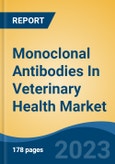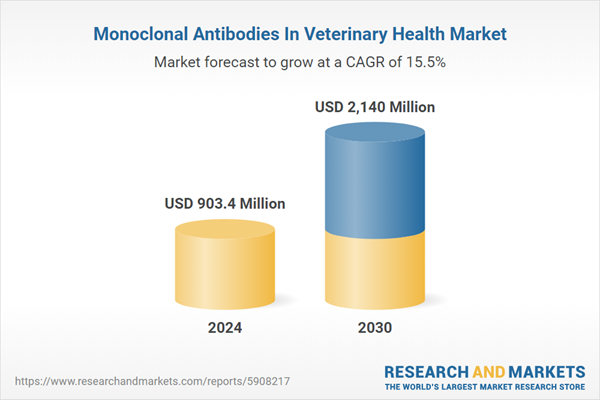Free Webex Call
Global Monoclonal Antibodies In Veterinary Health Market was valued at USD 903.40 Million in 2024 and is anticipated to project impressive growth in the forecast period with a CAGR of 15.50% through 2030. The global monoclonal antibodies (mAbs) in veterinary health market represents a rapidly growing segment within the broader animal healthcare industry. Monoclonal antibodies, which are lab-engineered antibodies that can target specific antigens, are increasingly being adopted in veterinary medicine for their therapeutic and diagnostic applications. Speak directly to the analyst to clarify any post sales queries you may have.
10% Free customizationThis report comes with 10% free customization, enabling you to add data that meets your specific business needs.
Key Market Drivers
Increasing Companion Animal Ownership and Pet Humanization
The increasing trend of companion animal ownership, coupled with the growing humanization of pets, is a major driver of the Global Monoclonal Antibodies (mAbs) in the Veterinary Health Market. Over 50% of the global population is estimated to own a pet, with dogs being the most prevalent, found in approximately 33% of households worldwide. Cats are the second most popular choice, owned by nearly 25% of pet-keeping households. This widespread pet ownership trend reflects a significant and growing market opportunity for pet-related industries, including food, healthcare, accessories, and services, driven by increasing consumer demand and the human-animal bond. As pet owners demand higher-quality healthcare solutions for their animals, the market for advanced veterinary therapeutics, including monoclonal antibody-based treatments, is experiencing significant growth.Households in the U.S., EU, and China collectively own over 500 million dogs and cats, underscoring a massive and expanding market for pet healthcare solutions. In the U.S., pet ownership grew from 68% of households in 2016 to 70% in 2021, reflecting a sustained upward trend in companion animal adoption and increased consumer spending on veterinary care. Over the past decade, there has been a significant increase in pet adoption rates, particularly in developed economies such as North America, Europe, and parts of Asia-Pacific. Factors such as rising disposable incomes, changing lifestyles, and a growing preference for emotional companionship have contributed to this trend. With pet ownership on the rise, there is a corresponding increase in demand for effective veterinary treatments, including monoclonal antibodies for conditions such as arthritis, dermatological disorders, and cancer.
Key Market Challenges
High Development Costs
Developing monoclonal antibodies is a complex and expensive process. Research and development costs can be prohibitively high, which poses a significant challenge for smaller biotech companies and startups looking to enter the market. These high costs can limit the diversity of players and the range of mAb products available.Key Market Trends
Expansion of Targeted Therapies
One of the most significant upcoming trends is the expansion of targeted therapies using monoclonal antibodies. As our understanding of animal diseases and their molecular mechanisms deepens, researchers are developing mAbs that can target specific disease pathways with precision. This trend promises to provide veterinarians with a broader range of effective treatment options for a variety of conditions.Key Market Players
- Zoetis Inc.
- Merck & Co., Inc.
- Elanco LLC
- Boehringer Ingelheim GmbH
- Indian Immunologicals Ltd
- Virbac SA
Report Scope:
In this report, the Global Monoclonal Antibodies In Veterinary Health Market has been segmented into the following categories, in addition to the industry trends which have also been detailed below:Monoclonal Antibodies In Veterinary Health Market, By Animal Type:
- Dogs
- Others
Monoclonal Antibodies In Veterinary Health Market, By Application:
- Dermatology
- Pain
- Others
Monoclonal Antibodies In Veterinary Health Market, By End-User:
- Veterinary Hospitals
- Others
Monoclonal Antibodies In Veterinary Health Market, By Region:
- North America
- United States
- Canada
- Mexico
- Europe
- Germany
- United Kingdom
- France
- Italy
- Spain
- Asia-Pacific
- China
- Japan
- India
- Australia
- South Korea
- South America
- Brazil
- Argentina
- Colombia
- Middle East & Africa
- South Africa
- Saudi Arabia
- UAE
- Kuwait
Competitive Landscape
Company Profiles: Detailed analysis of the major companies present in the Global Monoclonal Antibodies In Veterinary Health Market.Available Customizations:
With the given market data, the publisher offers customizations according to a company's specific needs. The following customization options are available for the report.Company Information
- Detailed analysis and profiling of additional market players (up to five).
This product will be delivered within 1-3 business days.
Table of Contents
1. Product Overview
2. Research Methodology
3. Executive Summary
5. Global Monoclonal Antibodies In Veterinary Health Market Outlook
6. North America Monoclonal Antibodies In Veterinary Health Market Outlook
7. Europe Monoclonal Antibodies In Veterinary Health Market Outlook
8. Asia-Pacific Monoclonal Antibodies In Veterinary Health Market Outlook
9. South America Monoclonal Antibodies In Veterinary Health Market Outlook
10. Middle East and Africa Monoclonal Antibodies In Veterinary Health Market Outlook
11. Market Dynamics
12. Market Trends & Developments
13. Porter’s Five Forces Analysis
14. Competitive Landscape
Companies Mentioned
- Zoetis Inc.
- Merck & Co., Inc.
- Elanco LLC
- Boehringer Ingelheim GmbH
- Indian Immunologicals Ltd
- Virbac SA
Table Information
| Report Attribute | Details |
|---|---|
| No. of Pages | 185 |
| Published | March 2025 |
| Forecast Period | 2024 - 2030 |
| Estimated Market Value ( USD | $ 903.4 Million |
| Forecasted Market Value ( USD | $ 2140 Million |
| Compound Annual Growth Rate | 15.5% |
| Regions Covered | Global |
| No. of Companies Mentioned | 6 |









